The words “full moon” in many languages

It is said that there are more than 6,000 languages worldwide (this is hard to imagine) and it is a fascinating concept to think, there are probably as many words for “full moon”.
Here we begin our little journey to the full moon. A few words about the fascinating quest of the greater purpose, that includes the full moon circulating through our lives. In layman’s terms and not always scientific (astronomy experts – don’t look too closely!). We would like to wish you illuminating moments. Enjoy!


It is said that there are more than 6,000 languages worldwide (this is hard to imagine) and it is a fascinating concept to think, there are probably as many words for “full moon”.
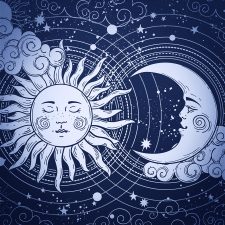
A full moon is when the Sun and the Moon are facing opposite, being in opposite direction from an Earth perspective.
This might feel astonishing if one imagines that the Moon is on one side, the Sun on the other and the Earth in between? Shouldn’t the Earth throw a shadow onto the Moon? Bingo – this is exactly what she does! But only when the Moon is exactly on the Earth orbit, the so called “ecliptic”. When this takes place, we speak of a lunar eclipse!
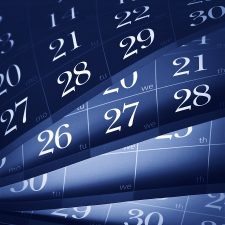
The Moon needs 27.33 days to circle around the Earth. Something that is also referred to as “sidereal time”. But because the Earth orbits the Sun, just like the Moon orbits the Earth, the Moon has to travel two further days in order to resume the same position to the Earth and Sun. This is then called the “sidereal time”. In order to determine the point of time of the reoccurring full moon, the sidereal time serves as basis.
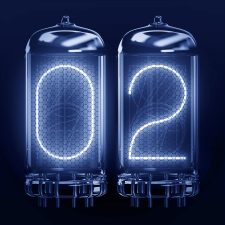
We already know now that the moon month is mostly shorter than the calendar month, being on average approximately 29.5 days. If full moon falls on the first or second of a month, it is possible that another full moon occurs in the same month, for instance in July 2004:
Friday, 2 July 2004, 01:08:54 pm
Saturday, 31 July 2004, 08:05:06 pm
This event is also known as “blue moon”.

The answer is: “everywhere at the same time”. This refers to the so called Universal Time (UT) though, which is used for general astronomical events. We have already learnt that full moon is an astronomical event, where the moon, sun and the earth play a role by being in a specific position. So, full moon takes place at a specific time in the outer space. This point of time is specified by astronomers namely by the Universal Time.

There are multiple ways of approaching this question. If we look at it from a purely theoretical standpoint, we might be tempted to say that the full moon is infinitely short, since the phases of the moon are changing continuously. The moon is not yet quite full shortly before the full moon, and is already waning shortly afterwards.
However, there is a practical aspect that lets us quantify the full moon as a finite and measurable span of time: Since the Sun is significantly bigger than the Moon, its rays are able to reach just a little over half of the Moon’s surface. This means that the timespan in which the visible side of the Moon’s surface is irradiated (as seen from Earth) is longer than infinitely short.

Whether scientists, astrologers or esoterics, they agree on one thing: the moon influences earth and life on earth. For instance, it regulates the tides through its magnetism. Also continents feel the consequence of this magnetism and either raise or lower their position sometimes up to 26 cm.

In nature it is a known fact: for some animal species, mating takes place at full moon. However, the examples that can be found on this subject are rather simple. Full moon serves in some cases indirectly as the cause (for instance through the high water levels during the tides that the horseshoe crab uses to deposit its eggs) or also as the signal for both sexes of a species to begin at the exact same time to safeguard their future existence (a particular type of fly or also corals). It is understood that also wolves are led by full moon when it is time to mate.

… that people are looking for an argument at full moon or are especially happy …
… that if full moon is surrounded by a haze, a person dies …
… that you raise your hat three times to the moon (being a man) or you make a curtsey (being a woman), in order to protect yourself from misfortune until the next full moon …
… that whoever does not chink glasses with full moon at least once, does not deserve any happiness [Greek toast] …
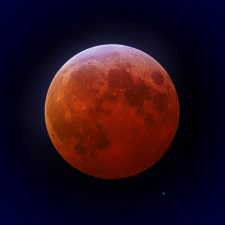
During a lunar eclipse, the Moon moves through the shadow of the Earth. Which means, that the Earth is positioned quite exactly between the Sun and Moon and casts its shadow onto the Moon. This is only possible at full moon and if some other requirements are met. Depending on whether the moon passes the partial or the core shadow of the Earth, we speak of a partial or total lunar eclipse.

The jazz classic »Fly Me To The Moon«, originally written by Bart Howard in 1954, gained worldwide fame through Frank Sinatra (1915–1998). His version from 1964 accompanied the space mission Apollo 10 to the Moon in May of 1969, and was played when the spaceship orbited the Moon. Further, it was the first song ever that was played on the Moon, when Buzz Aldrin stepped onto the Moon with a portable cassette player during the Apollo 11 mission in July 1969.
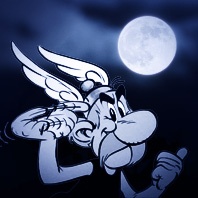
Who doesn’t know them, the fearless Gauls Asterix and Obelix, who have been making the hearts of comic fans leap for joy since decades and who impress again and again through witty texts and masterful drawings. The stories originate from the pen of the French illustrator Albert Uderzo (1927–2020), who created, together with his fellow countryman René Goscinny (1926–1977), the first comic in the year 1959, and with that, brought the adventures of the brave Gaul to life.

This is about how to differentiate the waxing moon from the waning moon in the sky. »Waxing« is known to be the lunar phase between the new moon and the full moon (meaning the time when the crescent increases in size), whereas »waning« is known to be the lunar phase between the full moon and the new moon (the time when the crescent decreases in size). In order to remember on which side the curve is, here are some neat mnemonics.

After we have already mentioned the lunate bone, one of the eight human carpal bones, which has been named after the Moon, due to its sickle shape, we would like to take another look at the human hand – this time at the fingernails. Lo and behold: here too, the name was inspired by the Moon. The white area of the nail, shaped like a half-moon is called »lunula« (lat. little moon) and incidentally, can be found on toenails as well. The lunula is differently pronounced with every human being, with some you may only see it on the thumb, with others you can see it on all fingers and toes.
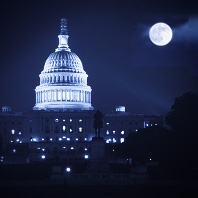
In the past, we have already reported about the antiquated word »lunatic«, which derives from the Latin »lunatus« and originally means »influenced by the Moon«. This term »lunatic« has been used in the English language, over several centuries for many forms of mental illnesses.

»The Lion King« from 1994, is one of the most successful animated movies, and just like in other works from the house of Walt Disney (»The Lady and the Tramp« and others), we are able to gaze at the full moon up in the sky in nightly scenes.
Particularly well-known is the image, where Simba dances across a tree trunk with his companions, which enables them to cross a large river in front of the backdrop of a gigantic full moon. This motif has also been used for various movie posters and can also be watched in the movie trailer:

Although, one could easily presume that full moon influences the reproduction of many creatures, this has really only been proven for some species. One assumes this is the case with wolves, specific insects or crabs and also many humans vow not being able to do anything other than to look for the closeness of the other (or the same) sex at full moon. But absolutely certain are scientist only about one animal species that may not even be considered an animal by many: the corals. Here it has been established that reproduction is dependent on water temperature and moon light.
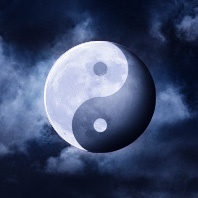
In view of the two original principles »feminine« and »masculine«, it is tempting to attribute the feminine, receiving principle to the moon and the masculine, creative principle to the sun. And most languages, where nouns posess articles, do reflect this, like for example the Romance languages (French, Spanish, Portuguese, Italian). However, there are a number of languages, for example German, Norwegian, Polish, Slovenian, Serbian or Czech, where the moon is masculine.
So, does the moon contain more masculine quality, after all, than originally assumed?

The »sunfish« is called »moonfish« in many languages. It is the biggest and heaviest bony fish in the world, weighing up to 2,500 kg and showing off up to 3 m length and 4 m height! It can grow over 100 years old. Its Latin name »mola mola« derives from its shape, which reminds of a »millstone«, but apparently, also the Moon was the force behind the naming:

This animation of 2013 is the most successful movie by the Disney Animation Studios yet, and supersedes the previous hit “The Lion King“. Not only in the US and Japan, but this production also received many awards in Germany (amongst other things the Oscar 2014 for ›Best Animated Feature‹ and ›Best Original Song‹) and was a box office hit.